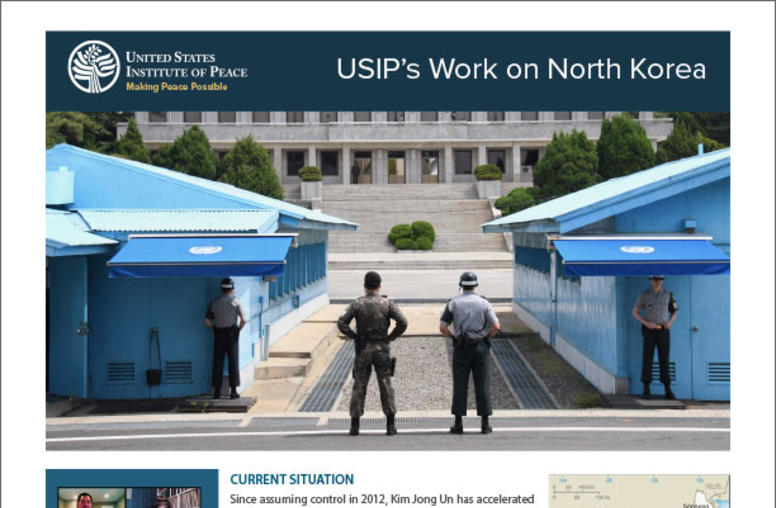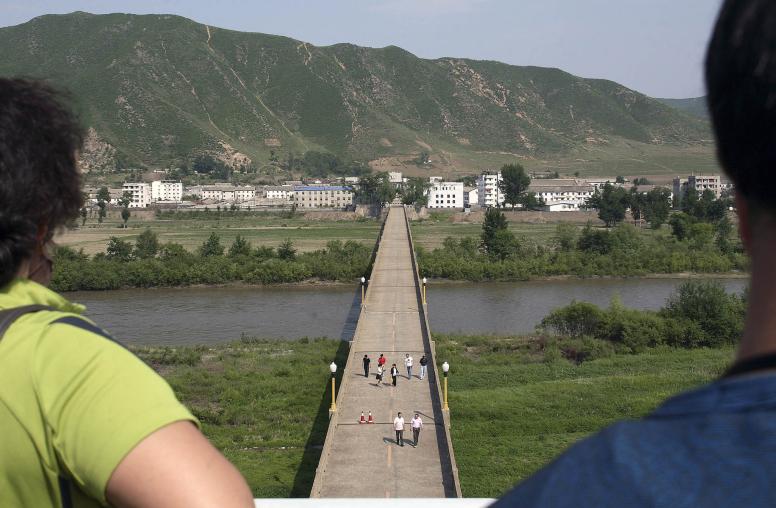A New Approach to Recovering U.S. Servicemen’s Remains from North Korea
Relying on an NGO to take the lead on remains recovery would sidestep friction between Washington and Pyongyang.
This essay is part of a series, Pursuing Peaceful Coexistence with North Korea, that explores how the United States and South Korea can peacefully coexist with a nuclear North Korea.
Seventy years after the end of the Korean War, there are still more than 7,000 U.S. servicemen who remain missing in action from that conflict. The remains of some 5,200 of these men are believed to be in North Korea. Unfortunately, poor diplomatic relations between the United States and North Korea have prevented the recovery of these remains. There is, therefore, a need for an alternative to the usual paradigm for conceiving, planning and implementing the recovery of U.S. war dead from North Korea. Usual practices might not carry the task, and ignoring the responsibility to bring our missing servicemen home should not be an option.

Accounting for Missing U.S. Servicemembers from the Korean War
The Korean War Armistice Agreement called for a limited time period for the recovery and evacuation of deceased prisoners of war and those missing in action (POW/MIAs). As part of Operation Glory in 1954, North Korea unilaterally delivered over 4,000 sets of remains of United Nations Command soldiers, most of which were identified as U.S. servicemembers.
After this initial operation, however, further accounting didn’t occur until the early 1990s when relations between the United States and North Korea began to thaw. North Korea unilaterally repatriated the remains of nearly 200 U.S. servicemen between 1990 and 1994. Then, between 1996 and 2005, the United States and North Korea conducted 37 joint recovery operations (JROs) that resulted in the repatriation of the remains of 153 U.S. servicemen. The United States ended the JROs in 2005 due to concerns about the safety of the U.S. workers.
Subsequent efforts to resume recovery operations also faltered due to diplomatic tensions. In 2012, new negotiations between the United States and North Korea led to an interim nuclear deal as well as an agreement to resume JROs. However, a North Korean satellite launch in April 2012 sank both agreements. In 2018, North Korea unilaterally delivered 55 boxes of remains as a goodwill gesture following the bilateral Singapore summit, with many of the remains later being identified as those of U.S. servicemen. Although the remains issue was a part of the negotiations leading up to the February 2019 Hanoi summit, the failure to reach a diplomatic agreement meant that communications related to future JROs ended soon thereafter.
Today, various hurdles continue to impede remains recovery operations. The primary obstacle is political. Poor bilateral relations make JROs difficult for both sides and even prevent private recovery efforts. Currently, U.S. restrictions on individual engagement with North Korea, such as the ban on U.S. citizen travel to North Korea and onerous processes for getting licenses or sanctions waivers related to transacting with North Koreans, impact private avenues for recovering remains. North Korea’s self-imposed border lockdown due to COVID concerns since 2020 has also undermined engagement opportunities.
Yet, recovering the remains of U.S. servicemen is imperative. It is a humanitarian issue that should not be impacted by political or diplomatic differences. Families of the missing men need closure, and repatriation of their loved ones’ remains can provide some healing. Also, the U.S. government has pledged to leave no man behind, and yet it has done so. Resumption of recovery operations would signal to the families of the missing, to active military members and to the country as a whole that the United States honors and remembers its warriors. The men who remain missing gave their lives in defense of the country. We owe it to them to learn their fates and bring them home.
A Potential Path Forward
Given the diplomatic obstacles, it is time to consider a different path to resuming remains recovery. The most viable recourse in the near term would be for a nongovernmental organization (NGO) to explore potential opportunities for remains recovery. This course would help sidestep the intergovernmental friction.
Recent changes to the political and security environment might facilitate such an approach. North Korea is beginning to emerge from its border shutdown, including allowing some foreigners, as well as its own citizens stationed abroad, to enter the country. This could augur the potential for U.S. citizens to visit as well. Also, over the last few years, the U.S. government has announced policy changes that were intended to facilitate humanitarian efforts related to North Korea. These changes include allowing for multiple-entry (rather than single-entry) special validation passports and facilitating streamlined UN processes for seeking waivers from North Korea-related sanctions.
An NGO-led project would likely proceed in multiple stages. The first stage would involve research near areas of known U.S. losses in North Korea. A joint NGO-North Korea investigative team could identify appropriate sites for recovery operations. Working together on such a project would help build a foundation of cooperation and mutual respect.
In traveling to loss sites, the team would meet with members of the local population to obtain needed information, whether it be firsthand knowledge or even general accounts regarding circumstances of loss missions, known details pertaining to the fate of crew members and location of grave sites.
If North Korea initially declines to allow representatives of the NGO to enter the country, the NGO could partner with qualified individuals from countries that have diplomatic ties with North Korea and are permitted entry. Alternatively, a team of North Korean professionals could conduct inquiries themselves and report collected information back to the NGO project team. Regardless of who comprised the exploratory team, the first stage of the project would likely involve forensic and other studies on an as needed basis.
The next step would require discussion and analysis of initial findings between North Korean and NGO representatives — individuals who have a professional or personal interest in locating and repatriating U.S. remains and are knowledgeable about past and current efforts to account for missing U.S. servicemen. The NGO side would not need to include U.S. government officials.
From there, discussion of how the operations would unfold could begin. This would depend on the U.S. and North Korean governments’ willingness to cooperate despite the ongoing diplomatic and nuclear weapons stalemates. If one or both sides remain unwilling, the project would be put on hold until the situation eased.
If the two sides came to terms, the NGO would send a delegation to meet with North Korean officials at a mutually agreed upon location to devise detailed plans for conducting remains recovery operations.
The final stage would require the entry of officials from the U.S. Defense POW/MIA Accounting Agency (DPAA) along with other civilians with relevant credentials to bring together the various components of the operations, negotiate operational procedures and finalize a bilateral agreement to resume JROs.
As mentioned above, enlisting help from a third country that has diplomatic ties with North Korea, such as Sweden, might expedite the cooperative effort. A neutral go-between could impress upon North Korean officials the potential benefits of allowing this humanitarian project to proceed — benefits such as future humanitarian aid, increased goodwill and financial remuneration.
Possible Challenges
The main challenge to the resumption of remains recovery, regardless of who leads the project team, is the constant potential for politics to complicate what should be a strictly humanitarian endeavor. North Korea would have to be amenable to permitting foreigners into the country for exploratory work. For its part, the United States would have to grant necessary licenses for the project and approve special validation passports for travel to North Korea based on humanitarian considerations or a determination that remains recovery is in its national interest.
Both countries would also have to officially greenlight the operations, pursuant to which DPAA officials would ultimately work side by side with Korean People’s Army soldiers, even though denuclearization talks remain deadlocked, North Korea maintains its military testing and U.S.-South Korea joint military exercises continue near the demilitarized zone, which North Korea interprets as a threat. This collective scenario would be unprecedented since JROs have previously only occurred during periods when there was positive diplomatic dialogue and reduced tensions.
Such an extraordinary situation might well require both sides to compromise on various policies. Additionally, the two countries might have to ensure that any funds paid to North Korea in furtherance of the JROs are applied to the intended cause and not to the North Korean military. Another safeguard against undesirable repercussions might be to restrict licenses in terms of amount such that only relatively small projects would be authorized, thus eliminating the potential for infusion of significant funds into North Korea’s military.
In an ideal situation, the two countries would resume JROs amid renewed diplomatic engagement. But the United States and the POW/MIA families cannot wait for the ideal political situation. The mission of recovering servicemembers’ remains must continue despite the reality of frequently hostile bilateral relations. An NGO-led effort could help advance this cause.
Successful cooperation on the remains recovery issue could also help promote progress on political issues. The late U.S. ambassador to the United Nations, Bill Richardson, a renowned promoter of international peace and dialogue who facilitated North Korea’s return of seven U.S. servicemen’s remains in 2007, noted, “The way you deal with issues that divide nations is through humanitarian efforts before political differences.”
In 2016, members of the Richardson Center for Global Engagement and the Coalition of Families of Korean & Cold War POW/MIAs traveled to North Korea to discuss remains recovery. This exchange came about despite ongoing tensions at the time, including North Korea’s fifth and sixth nuclear tests. Another such discussion could help restart remains recovery operations and, perhaps, serve as a model for peaceful coexistence between the two countries.
Donna Knox, co-founder of the Coalition of Families of Korean & Cold War POW/MIAs, is an attorney, a writer and a 30+ year advocate for the fullest possible accounting of missing U.S. servicemen, one of whom is her father.



